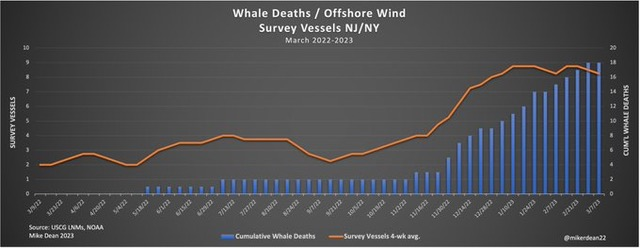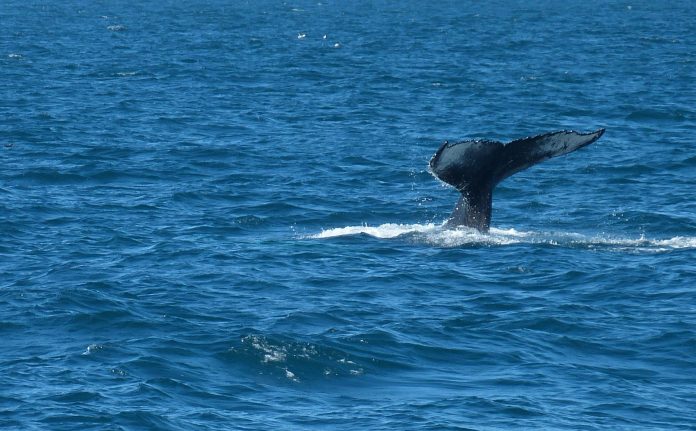The Washington Post (WP) ran a story discussing the possibility of counting whales as carbon sinks or offsets, concluding that any carbon stored in whales would be insufficient to offset more than a fraction of human carbon dioxide emissions. This is true, and especially so as there is mounting evidence to suggest that efforts to fight climate change by building large industrial offshore wind projects are contributing to a growing rate of excess whale deaths.
In the WP story, “Whales Are the New Trees: Neither Will Save the Climate,” author Mark Gongloff writes:
A few years ago, a group of economists proposed that whale populations be treated as counterweights to pollution, much in the same way that supporting tree-planting allows individuals and businesses to “cancel out” their carbon emissions.
Here’s the basic idea: Whales store a lot of carbon in their massive bodies. They also poop prodigiously, creating a food source for phytoplankton, which themselves collectively hold even vaster amounts of carbon. And when whales die, their bodies sink to the ocean floor, trapping carbon in deep water for hundreds of years.
Although Gongloff supports the goal of enhancing whale populations, he notes a number of problems with efforts to treat whales as carbon sinks for the purpose of fighting climate change, among them, “is that nobody really knows how much carbon whales actually trap, or for how long,” and any carbon they store is miniscule compared to daily emissions from human activities.
Whales are worth protecting regardless of their ability to store carbon dioxide. Strictly as carbon sinks, however, the fact is, whales can’t serve that purpose if they are dying as a result of efforts to build and operate massive offshore wind projects.
As part of President Biden’s stated goal of reducing U.S. greenhouse gas emissions 50 percent below 2005 levels by 2030, the Biden administration has initiated efforts build 30,000 megawatts of traditional offshore wind facilities (with structures attached to the ocean floor) in federal waters by 2030, and an additional 15,000 megawatts of floating industrial offshore wind by 2035. To hit those targets, the Biden administration is soliciting leases in federal waters in the Gulf of Mexico and Gulf of Maine and off the coasts of New England, the Mid-Atlantic States, North Carolina, South Carolina, California, and Oregon.
These lease areas are in the middle of or at the edges of numerous protected whale species core habitat and migration routes.
Gongloff and the WP dismiss the threat offshore wind projects pose to whales with a single paragraph:
You might be thinking: So what? If we can dangle carbon offsets as a lure to companies to not only stop killing whales with their ships (likely the primary cause of a recent spate of whale fatalities; not wind farms, as you might have heard) but also pay money to protect them, then isn’t that a good thing?
Yet, whale deaths and strandings have spiked since 2016 as the Bureau of Ocean Energy Management first began and sanctioning the sound testing for and initial construction of large offshore wind farms (see the figure below).

Although the sonic pulses may not be directly causing whale deaths, each wind project is being issued level 2 harassment permits to “disturb a marine mammal or marine mammal stock in the wild by causing disruption of behavioral patterns, including, but not limited to, migration, breathing, nursing, breeding, feeding, or sheltering …,” from the National Marine Fisheries Service (NMFS). One would have to be willfully ignorant to believe sonar testing is not harming whales when the NMFS says it likely is or will.
In a letter sent to Department of Interior officials on May 13, 2022, Sean Hayes, chief of the protected species branch at NOAA’s National Northeast Fisheries Science Center wrote:
Additional noise, vessel traffic and habitat modifications due to offshore wind development will likely cause added stress that could result in additional population consequences to a species that is already experiencing rapid decline. Wind turbines may disrupt the dense concentration of zooplankton that the whales depend on for sustenance, potentially forcing them to spend more energy and take more risks searching elsewhere for food.
Adding weight to the concerns raised by Hayes is the fact that 10 whale and sea life conservation organizations sent an official letter to Bureau of Ocean Energy Management specifically objecting to the Biden administration moving forward with offshore wind plans and approvals without a comprehensive environmental impact statement demonstrating that such projects would have no deleterious impacts to whale populations.
Ship strikes are the single largest cause of excess whale deaths and shipping traffic has increased along the Atlantic coast. The ships associated with offshore wind sonar activities, cable laying and construction, have contributed a bit to this increase.
While undertaking acoustic surveys multiple ships traverse areas whales use as calving and feeding grounds, migration corridors, and where some whales reside year around. Even if the sound does not directly harm the whales, it is virtually guaranteed to force them out of their normal habitats into one of the busiest shipping corridors in the world. Indeed, since the pandemic, the Port of New York and New Jersey has become the busiest in the nation.
Patrick Moore, a co-founder of Greenpeace and its ex-president in Canada, told the New York Post (NYP) that offshore wind development is creating “death zones” for whales.
“The effect of the high-intensity acoustic pulses is unknown, and the excavations are muddying waters for what will be years on end,” Moore said. “It is not reasonable to say there is no possibility of a causal relationship.”
New Jersey state Sen. Anthony Bucco (R-Boonton) agrees with Moore’s assessment of the impact of offshore wind development on whale populations, telling the NYP:
There’s too much of a coincidence here to ignore, and we continue to rapidly push forward. This activity off our coast is only going to dramatically increase as they begin pile-driving and installing these wind turbines. So if this is having an effect on our marine mammals now, it could be catastrophic when that work begins.
Even if offsetting carbon dioxide emissions were a worthwhile goal, which Climate Realism disputes, the WP and Gongloff are right, using whales as carbon dioxide offsets won’t work, especially since offshore wind development to fight climate change is increasing whale deaths.

















